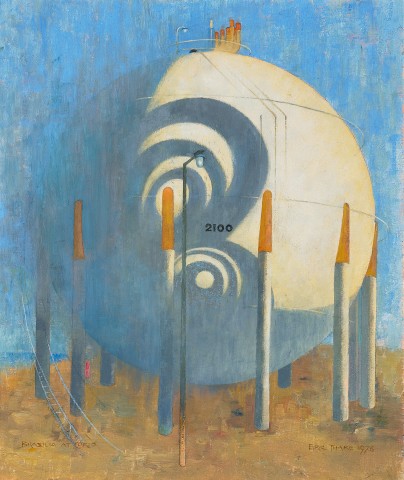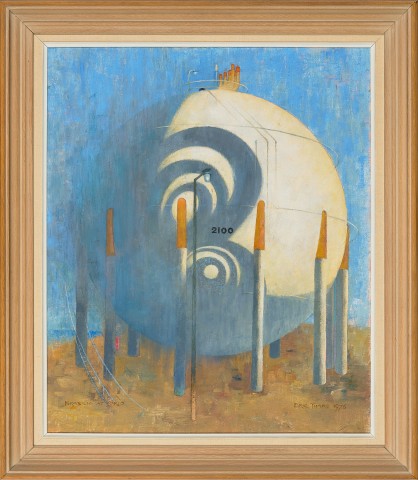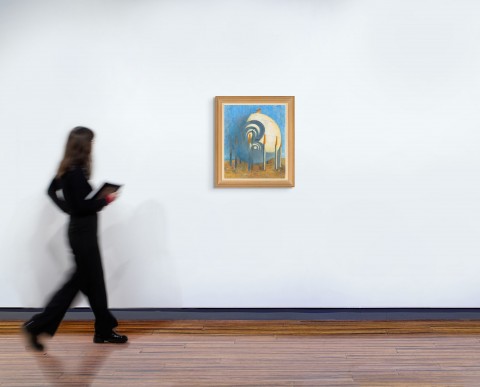BRASILIA AT CORIO, 1976
ERIC THAKE
oil on canvas board
60.0 x 50.0 cm
signed and dated lower right: ERIC THAKE 1976
inscribed with title lower left: BRASILIA AT CORIO
inscribed with title verso: “BRASILIA AT CORIO”
Estate of the artist, Victoria
Thence by descent
Private collection, Melbourne
Eric Thake, Geelong Art Gallery, Victoria, 15 October – 28 November 1976, cat. 29
Eric Thake, Macquarie Galleries, Sydney, 2 – 14 February 1977, cat. 17
A keen observer of the world around him, Eric Thake always carried a sketchbook so that he could record what he saw. As a child he was enthralled by Cole’s Funny Picture Books, especially their visual puzzles, and credited them with his habit of seeing the unexpected and the unfamiliar in the everyday. This unique perspective was combined with a distinctive sense of humour and an eye for design, born in part from the experience of working in the art department of Patterson Shugg process engravers from 1918, and later, as a commercial artist. A draftsman, painter and printmaker of refined skill, Thake produced some of the most memorable images of mid-twentieth century Australian art.
From the early 1970s Thake lived at Geelong where the Corio docks and surrounding industrial landscape captured his attention. The largest painting in his oeuvre, Brasilia at Corio, 1976 depicts a singular gas silo which fills the pictorial space with its huge spherical form. While the artist has paid attention to the details of his subject, he has also played with reality, subtly modifying elements in the service of composition, story-telling and design. Photographic images of similar silos show, for example, that the elegant curve of the external stairs sweeping around the left-hand-side of Thake’s silo is pure artistic invention, while the flash of red which represents a fire extinguisher dwarfed by the looming bulk of the silo is a classic example of his ironic humour.
The most striking element of this image is the depiction of light and shadow, and in particular, the concentric circles reflected on the silo’s front. Thake’s daughter recalls him explaining that this was simply the result of the way that the sun hit the vertical supporting poles – no doubt with a little artistic licence thrown in.1 The graphic quality of these reflected patterns, the geometric form of the silo and its bright white colour presumably inspired the title which, in characteristic Thake style locates the exotic in the everyday, aligning the industrial waterfront of Geelong with the federal capital of Brazil, a planned city and marvel of modern design and construction (involving, among others, architect Oscar Niemeyer and landscape architect, Roberto Burle Marx) which was inaugurated in 1960.
Thake was the first Australian surrealist and this aspect of his art was identified as early as 1933 when he showed Bluebells, Blue River, 1932 (National Gallery of Victoria) in the annual Contemporary Art Group exhibition. Reviewing the show, Blamire Young observed insightfully that ‘His juxtapositions are sometimes surprising’2 and this is one of the defining characteristics of Thake’s oeuvre. While he was aware of the work of English and European surrealists such as Giorgio de Chirico, Edward Wadsworth and Paul Nash (possibly having seen their work in local exhibitions, but known primarily in reproduction from books, magazines and postcards), what distinguishes Thake’s art from that of his peers is the unique ability to construct ‘a bricolage of everyday images to unfix and change, this way and that, the world around us.’3 Indeed, by incorporating the lessons of surrealism into his vision of the world, no matter how apparently banal his subject matter, Thake’s images are at once familiar and yet full of mystery, the uncanny and the unexpected.
1. Conversation with Jenifer Beaty, 4 October 2024
2. Young, B., The Herald, Melbourne, 1 August 1933, cited in Eagle, M. and Minchin, J., The George Bell School: Students, Friends, Influences, Deutscher Art Publications, Melbourne, 1981, p. 26
3. Eagle, M., ‘The 1920s and Eric Thake’ in Eagle & Minchin, ibid.
KIRSTY GRANT


